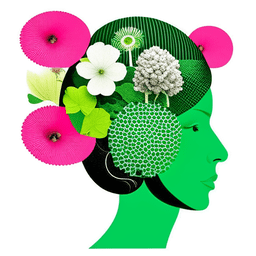Autism Acceptance Month 2024: Neurodivergence in the workplace

The presentation is freely available in my Google Drive if anyone wants to download it and adapt for their own use.
How does an AuDHD person, aka me, create a presentation?
Being AuDHD, my brain fights between wanting to provide a perfect presentation that is extremely detailed and waiting until the morning of the presentation to get things done when panic triggers the dopamining response. Here's my process:
- The week before the presentation, hyper focus on perfecting the first image in the slide deck.
- Half way through the week, realise you are a wee bit side-tracked and rapidly create eleventy-hundred in-depth slides on a variety of subjects, side-quests, and completely unrelated topics.
- The day before the presentation, find out how long you have for the presentation.
- Realise there's no way you'll get through all eleventy-hundred slides in the allocated time, start the cull - removing 80% of the slides may do it.
- An hour before the presentation, rearrange all slides into a logical order. The autistic side of my brain breathes a sigh of relief at the now organised and tidy slide deck.
- Ten minutes before the presentation, notice feedback from the colleague you asked to peer review, than mad panic fix broken links and typos.
- While in there updating, add a video from TikTok because ten mins is LOADS of time, innit.
- Log on to the meeting early. Autistic side of brain is baffled as to how we managed this.
- Almost get through all the slides in the allotted time, tell folks there's three left, are they okay to keep going? Everyone says, yes!
- 10 minutes after the meeting was supposed to end, finish the presentation and ask if there are any questions.
- Spend rest of day recovering.
- Have several days of people sending slack messages saying how much they learned and enjoyed the talk. Awesomeness.
Workplace inclusivity - create a safe space for all your staff
The benefits of a diverse workforce
- Autistics are up to 140% more productive than neurotypical employees
- Autistic employees got up to speed faster when starting a new job or task
Learn about Rejection Sensitive Dysphoria (RSD)
RSD impacts 98%-99% of ADHD/ASD people.
Rejection-sensitive dysphoria refers to an extreme and often distressing emotional response to perceived rejection or criticism, which goes beyond the typical range of reactions. This pain can significantly disrupt a person's capacity to engage in relationships, work, and various aspects of life. Imagine experiencing a surge of emotions that far surpasses your expectations when you detect even the slightest hint of rejection or criticism – even if it wasn't intended as such. RSD acts as an amplifier for these emotions, taking them to distressing and overpowering levels.
- https://neurodivergentinsights.com/blog/rejection-sensitive-dysphoria
- https://www.authenticallyemily.uk/blog/rejection-sensitive-dysphoria
Read up on Milton's Double Empathy Problem
"Autistic empathy is no less compassionate, no less thoughtful, no less ‘human’ than non-autistic empathy: it is simply different." Milton, D. E. M. (2012). On the ontological status of autism: The ‘double empathy problem’. Disability & Society, 27(6), 883-887.
The problem:
- Autistic people are assumed to be lacking empathy and theory of mind - they are not. ND people do not lack empathy or theory of mind, they experience and express it differently.
- Non-autistic people have no issue communicating with other non-autistic people or understanding them.
- Autistic people have no issue communicating with other autistic people or understanding them.
- Autistic and non-autistic people struggle to communicate and understand each other, BUT, only autistics are regarded as having a deficit in communication skills.
- This is a double problem because both groups experience a lack of understanding and a failure of communication skills.
- There is an empathy divide between the two side.
What is the impact of this empathy divide?
The empathy divide is experienced by both autistic and non-autistic people, BUT, these groups are not equally affected by the divide.
- Communication
- The non-autistic way of communicating is typical and therefore regarded as 'normal', 'superior', 'preferable', and 'correct' by most people.
- The autistic way of communicating is deemed 'abnormal' and 'incorrect'.
- Fitting in
- Autistic people are expected to learn non-autistic culture and communication.
- Non-autistic people are NOT expected to learn or understand autistic perspectives.
- Discomfort & trauma
- Autistic people are frequently expected to ignore their own discomfort in order to make the non-autistic people around them feel comfortable.
- Non-autistic people are NOT expected to ignore their own discomfort to make ND people around them feel comfortable.
- Autistic people are frequently given 'treatment plans' to help them understand non-autistic perspectives. These 'treatments' result in PTSD in around 85% of autistic adults who have been through the 'treatments'. ABA teaches autistic kids to hide sensory pain, become people pleasers, ignore their own pain and feelings, and it increases the likelihood of PTSD, sexual assault, and suicide in autistic people. Gay conversion therapy stems from the 'treatment' used for autistic kids, and that is now banned in many places because it's horrific, but ABA conversion therapy is still allowed to traumatise kids. Read more here
Notes created from https://reframingautism.org.au/miltons-double-empathy-problem-a-summary-for-non-academics/ by Dr Melanie Heyworth
Communication that is safe for all
|
“Hey, can we have a quick chat?” |
Please don’t say this without providing a reason. Instead try “Can we have a chat about XYZ?” |
|
Good news / bad news / good news s&wich |
Yeet this management shit sandwich into the sun! |
|
Assuming implied or hidden meaning |
Assume others say what they mean, not what you think they mean! If a neurodivergent person asks "why did you do it that way?" it is not a criticism, it is a genuine question. |
|
Using implied language |
Be explicit & direct, say what you mean. If you think something is wrong, or you don't like what is being done, don't ask "why did you do it that way?", we'll just answer the actual question and tell you why we're doing it that way. If you want to go for coffee, don't say "oh, I really fancy a coffee" then get offended when we say "okay, see you later then". If you want us to go with you, ask the actual question "do you want to go for a coffee with me." Being explicit will prevent hurt feelings on both sides. On the side of the neurotypical for thinking their "invitation" has been rebuffed, and on the part of the neurodivergent for thinking they never get invited out with the rest of the team. |
|
Don’t gaslight, even unintentionally |
If we say we mean one thing, don’t tell us we mean something else, refuse to believe us, & then get angry. It’s terrifying. |
|
Don’t diminish what a person is going through |
We’re not “all a little bit OCD”. |
Embrace different thinking and learning styles
|
|
Strengths |
Some useful learning styles & adaptations |
|
Dyslexia Dyscalculia Dyspraxia |
Creative, imaginative, strategic, outside the box & critical thinkers, intuitive |
Multi-sensory methods, H&s-on experience, Thrive with concise instructions & creative challenges |
|
ADHD |
Creativity, hyperfocus, energetic & enthusiastic |
Multi-sensory methods, H&s-on experience, Structured, Short, frequent breaks, Variety & flexibility |
|
ASD |
Attention to detail, strong memory, logical thinking, creativity, hyperfocus, honesty & integrity, pattern recognition |
Visual & multi-sensory methods, Structured & predictable, H&s-on experience, Individualised instruction, Concise instructions |
|
OCD |
Attention to detail, organisational skills, persistence, perseverance, problem solving abilities, creative, high st&ards of performance, innovative |
Structured & organised environment, clear & explicit instructions, visual aids & written instructions, regular breaks, movement, flexible learning options, emphasis of self care & well-being |
Meetings
|
Send out meeting agendas early. |
|
Encourage pre-meeting questions/answers to agenda topics. |
|
Remove agenda topics if answered/resolved prior to the meeting. |
|
Remove the entire meeting if pre-discussions answered/resolved all agenda items. |
|
Don’t have meetings for the sake of it. If you can resolve things in another way, then do so. |
|
Don’t make final decisions in the meeting. Allow post meeting processing time. |
|
Take notes & send them out immediately after the meeting. |
|
Record meetings if they’re technical or complex in some way so people can revisit topics later. Recording with transcribe on is even better, as then it’s automatic note taking :-) |
General People Management Ideas
- Respect boundaries & sensory sensitivities
- Read up on RSD, avoid triggering it
- Individualise accommodations
- Clarify expectations
- Provide clear feedback & support
- Provide open communication without fear of judgement
- Read up on “Spoon Theory” and make sure you keep an eye on your team. If they look like a break is needed, tell them.
- Allow self-care & wellness to be a priority
- Provide mentorship & guidance
- Encourage self advocacy
- Build genuine trust & rapport
- Try not to break routines
- But also… be flexible
- Don’t interrupt trains of thought
- Allow uninterrupted windows of time to focus
- Recognise & help maximise strengths
- Recognise & celebrate achievements
- Model inclusive behaviour
- Regular check-ins & support
- Help with assistive technologies & encouraging their use
I've been playing with the new AI ImageGen tool we have available at Envato. It's in Beta mode, but feel free to go check it out and have a play. All the images I'm using in this blog post have been created using this tool.






Comments